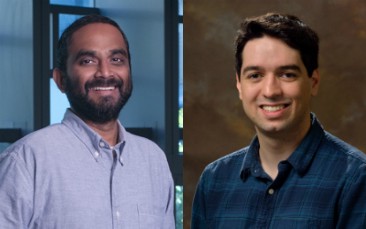Penn Engineers Look at How the Stretching and Alignment of Collagen Fibers Help Cancer Cells Spread

By Lauren Salig
Cancer has such a massive impact on people’s lives that it might be easy to forget that the disease originates at the cellular level. To spread and cause significant damage, individual cancer cells must navigate the fibrous extracellular environment that cells live in, an environment that Penn Engineer Vivek Shenoy has been investigating for years.
Shenoy is the Eduardo D. Glandt President’s Distinguished Professor with appointments in Materials Science and Engineering, Mechanical Engineering and Applied Mechanics, and Bioengineering. He is also the Director of the Center for Engineering MechanoBiology (CEMB), one of the NSF’s twelve Science and Technology Centers.

Shenoy’s most recent study on cancer’s mechanical environment was led by a postdoctoral researcher in his lab, Ehsan Ban. Paul Janmey, professor in Physiology and Bioengineering, and colleagues at Stanford University also contributed to the study.
The study was published in the Proceedings of the National Academy of Sciences.
As director of the CEMB, Shenoy is devoted to expanding the field of mechanobiology, which investigates how physical forces can shed light on biological processes in plants and animals. His research focuses on how cells, especially cancer cells, move through the extracellular matrix.
“We want to know: How do cancers metastasize? Cancer cells start at the original tumor, but then they have to travel through tissue and into blood vessels to spread,” says Shenoy.
“The way we can bring mechanics into this biological field is by looking at how cellular forces deform the fibrous cancer tissues,” adds Ban.
The extracellular matrix that surrounds a body’s cells is a viscoelastic material that has both solid and liquid properties. A large part of the matrix is made up of collagen fibers that play an important role in cell movement, based on how loose or stretched out the fibers are.
“When the fibers stiffen, they lay a railroad track for the cells to move,” says Shenoy. This railroad track becomes cancer cells’ mode of transport near the tumors.
The stiffness of the fiber networks changes due to the contractility of the cells, in turn affecting gene expression in the cells themselves.
In this study, Shenoy and Ban looked at the mechanics of extracellular collagen fiber networks using a more realistic three-dimensional (3D) setting that incorporates both computational and theoretical approaches. Their work was complemented by experimental studies of cancer cell invasion from Stanford and Penn.
“Previous literature has looked at what happens to these fiber networks when you stretch or shear them, but what these tissues experience is more complicated than that. We looked at a 3D perspective,” says Ban.
Analyzing the properties of collagen fibers using this 3D modeling, they discovered that the fibers had an unexpectedly extreme reaction to being stretched.
“If I take a rubber band and I stretch it, the width of the rubber band is going to shrink,” says Shenoy, describing what is known as the Poisson effect. “But when collagen is stretched, it shrinks way more than you would expect. Fibers oriented transverse to the direction of stretching actually buckle. The stretched fibers realign toward the direction of loading, and the networks get denser overall. That’s a pretty surprising thing.”
Cancer cells capitalize on this high alignment and density of fibers, which facilitate cell movement, to reach blood vessels and invade new areas of the body.
Shenoy and Ban believe their finding helps create a fuller understanding of the properties of collagen fiber networks and reconciles findings in the literature that, until this point, were seemingly contradictory. The results also show promise for a future in better simulations of and treatment for conditions like cancer and fibrosis.
The work was a collaboration between the Materials Research Science & Engineering Center (MRSEC) and the CEMB, which Shenoy sees as critical to the research’s success.
“It is truly interdisciplinary,” he says. “It actually brings the fields of biology, engineering, applied mathematics and physiology together. We really need all these people.”
The team plans to continue studying the extracellular matrix and hopes to look next at the impact of hyaluronic acid on the charge and fluid flow in these networks.
“Mechanics of how cancer cells invade can look like a big mess a lot of the time,” says Shenoy. “We see it as an opportunity.”
This work was supported by National Cancer Institute awards U01CA202177 and U54CA193417, National Institute of Biomedical Imaging and Bioengineering award R01EB017753, the NSF Center for Engineering Mechanobiology (CMMI-154857), and NSF grant MRSEC/DMR-1720530.
